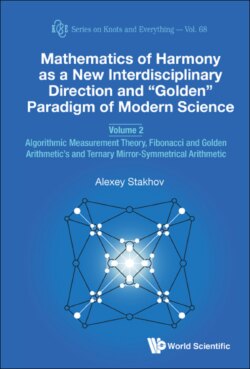Читать книгу Mathematics of Harmony as a New Interdisciplinary Direction and “Golden” Paradigm of Modern Science - Alexey Stakhov - Страница 13
1.3. The Problem of Infinity in Mathematics
ОглавлениеCantor’s axiom (Fig. 1.2) contains another amazing creation of mathematical thought, an abstraction of actual infinity. It is this idea of infinity that underlies the Cantor theory of the infinite sets [16].
The idea of actual infinity as the main idea of Cantor’s (set-theoretic) style of mathematical thinking was strongly criticized by the representatives of the so-called completed one it is impossible without gross violence over the mind, which rejects such contradictory fantasies.
Earlier, the famous mathematician David Hilbert (known for his “finite” installations) expressed the same idea in other words and, by discussing the concepts of the finite and infinite, came to the following conclusion [125]:
“From all our reasoning, we want to make some summary on infinity; the general conclusion is the following: the infinite is not realizing anywhere. The infinite does not exist in Nature, and this concept is unacceptable as the basis of our rational thinking — here we have a wonderful harmony between being and thinking … Operation with the infinite can become reliable only through the finite”.
The paradoxes or contradictions in Cantor’s theory of infinite sets, discovered at the beginning of the 20th century, significantly shook the foundations of mathematics. Various attempts have been made to strengthen them. The most radical of them is the constructive direction in the substantiation of mathematics [124], which completely excludes the consideration of the abstraction of actual infinity and uses a much more “modest” abstraction of the infinite called the abstraction of potential feasibility.
The contradiction between potential and actual infinities manifests itself most vividly in the mathematical theory of measurement [16], when we analyze the Eudoxus–Archimedes axioms (Fig. 1.1) and the Cantor axioms (Fig. 1.2).
To clarify this contradiction, let’s consider once again the “basic measurement equation” (1.2). The idea of this contradiction is as follows. With the help of the Eudoxus–Archimedes axiom, a certain sequence of the “contractible” segments, which are compared with the measured segment Q, is formed from the measurement unit V according to certain rules, called the measurement algorithm;when this process strives to infinity, on the basis of Cantor’s axiom, for any Q and given V, such segment Q, formed from V, which “absolutely exactly” coincide with Q, will always be found. The most essential part of this proof is a presentation about measurement, as a process that ends in an infinite time (according to Cantor’s axiom). Thus, at the initial stage of the proof of equation (1.2), we use the concept of the potential infinity (Eudoxus–Archimedes axiom), and at the final stage, we “jump over” this concept and use the concept of the actual infinity (Cantor’s axiom). In this regard, it is appropriate to cite the following quotation from the book [16]:
“It is appropriate to pay attention to the internal contradictoriness (in the dialectical sense) of the set-theoretic theory of measurement (and as a consequence of the theory of real numbers), which allows in its initial positions (continuity axiom) the coexistence of dialectically contradictory ideas about actual infinity: the actual infinityin Cantor’s axiom (and Dedekind’s axiom) and the potential infinity, that is, “becoming”, unfinished in Archimedes’ axiom”.
The existing mathematical theory of measurement and the theory of real numbers arising from it, based on Cantor’s axiom, are internally contradictory; but such theories, based on the contradictory axioms, cannot be the basis for mathematical reasoning! Otherwise, all mathematics becomes an internally contradictory theory. One wonder what had actually happened in mathematics at the beginning of the 20th century, when the contradictions were found in Cantor’s theory of infinite sets. It is surprising that such a simple idea was not noticed by mathematicians before the book [16].
